How do you rebuild or overhaul a small engine carburetor?
Rebuilding the carburetor may be required if basic adjustments don’t fix your small engine problems or improve performance on your lawn mower or outdoor power equipment. Follow the steps below for overhauling small engine carburetors.
![]() WARNING: Always read the engine and equipment manual(s) before starting, operating, or servicing your engine or equipment to avoid personal injury or property damage. Fuel and its vapors are extremely flammable and explosive. Always handle fuel with extreme care.
WARNING: Always read the engine and equipment manual(s) before starting, operating, or servicing your engine or equipment to avoid personal injury or property damage. Fuel and its vapors are extremely flammable and explosive. Always handle fuel with extreme care.
See an authorized dealer or contact Briggs & Stratton if you are unsure of any procedure or have additional questions. Find all Engine Safety Warnings
Step 1: Removing the Carburetor
Step 2: Disassembling A Float-Type Carburetor
Step 3: Inspecting the Carburetor
Step 4: Inspecting Air-Fuel Mixture Screws
Step 5: Reassembling the Small Engine Carburetor
Step 6: Attaching The Carburetor & Air Cleaner Assembly
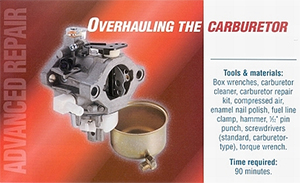
- Disconnect the spark plug lead and secure it away from the spark plug. Then, remove the air cleaner assembly.
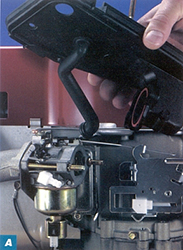
- Turn off the fuel valve at the base of the fuel tank. If your engine does not contain a fuel valve, use a fuel line clamp to prevent fuel from draining out of the tank while the carburetor is disconnected from the engine.
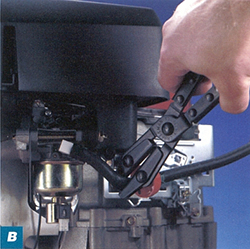
- Some carburetors contain an electrical device at the base of the fuel bowl to control afterfire. Disconnect the device, known as an anti-afterfire solenoid, by removing the wire connector from the solenoid's receptacle.
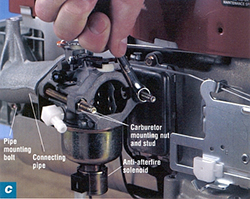
- With the carburetor still connected to the governor, unfasten the carburetor mounting bolts. If a connecting pipe joins the carburetor to the engine block, first remove the pipe mounting bolts. Then, disconnect the carburetor from the pipe by removing the nuts and sliding the carburetor off the studs. Sketch the governor spring positions before disconnecting them to simplify reattachment.

- Then, disconnect the governor springs and remove the carburetor, taking special care not to bend or stretch links, springs or control levers.
Your carburetor contains a small amount of fuel. Prepare a clean bowl to catch dripping fuel and store small parts. During disassembly, inspect the bowl for dirt and debris to determine the condition of your carburetor.
- Remove the fuel bowl from the carburetor body. The fuel bowl may be attached with either a bolt or the high-speed mixture screw.
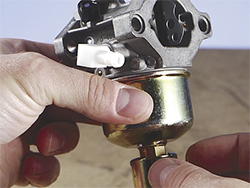
- Push the hinge pin out of the carburetor body with a small pin or pin punch. Take care to tap only the pin to avoid damaging the carburetor body.
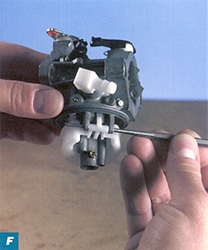
- Remove the float assembly, inlet needle valve and fuel bowl gasket.
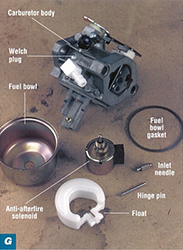
- If your carburetor contains an idle mixture screw, remove it along with the spring.
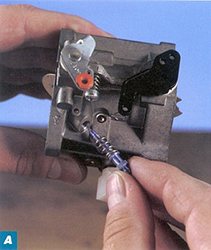
- Rotate the throttle plate to the closed position, remove the throttle plate screws and the throttle plate.
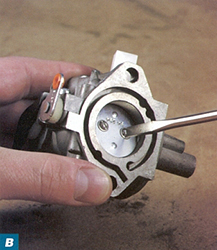
- Remove the throttle plate shaft and foam seal.
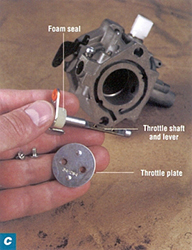
- Then, remove the choke plate and choke shaft and felt or foam washer in the same manner.
- Use your carburetor repair kit to identify replaceable welch plugs. These seals cover openings in the carburetor left over from machining. Insert a sharpened 5/32" pin punch at the edge of each plug to be removed and tap cleanly to free the plug.
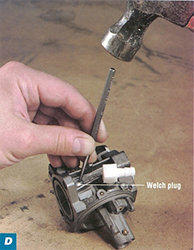
- Unscrew the main jet from the side of the carburetor pedestal (if equipped). Then, unscrew the emulsion tube; it may be screwed in tight. A carburetor screwdriver is the best tool for the job. It's designed to fit the slot in the head or the emulsion tube so that you won't damage the threads inside the pedestal of the tube itself as you loosen it.
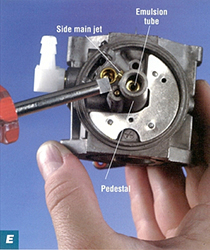
- Remove the emulsion tube.

- Soak metal and plastic carburetor parts in all-purpose parts cleaner for no more than 15 minutes to remove grit. Or, while wearing safety glasses, spray the parts with carburetor cleaner. Then, wipe away solvent and other residue thoroughly using a clean cloth. Never use wire or tools because they can damage or further obstruct plugged openings.
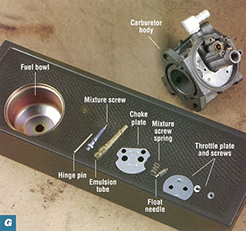
- Inspect all components and use additional carburetor cleaner to loosen stubborn grit and to clear obstructions.
- Replace any parts that are damaged or permanently clogged.
- Brass mixture screws control the air-fuel mixture at high speed and at idle. Over tightening can damage the tip of the screw so that proper adjustment is no longer possible.
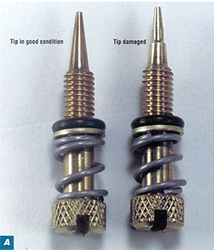
- Remove any non-metal parts and soak mixture screws in carburetor cleaner for 15 minutes.
- Then, inspect them carefully for wear. Replace a mixture screw if the tip is bent or contains a ridge.
- Install new welch plugs from your repair kit using a pin punch slightly smaller than the outside diameter of the plug. Tap on the punch with a hammer until the plug is flat (strong blows with the hammer will cause the plug to cave in). Then, seal the outside edge of the plug with enamel nail polish.
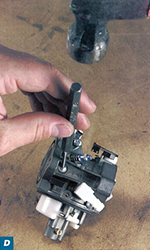
- Assemble the choke by inserting the return spring inside the foam seal and sliding the spring and seal assembly onto the choke shaft. Plastic choke plates have a stop catch at one end of the spring; metal plates have a notch to hold the hook at one end of the spring.
- Insert the choke shaft into the carburetor body and engage the return spring. If the choke lever uses a detent spring to control the choke plate position, guide the spring into the notched slot on the choke lever. Place the choke plate on the shaft with the single notch on the edge toward the fuel inlet. Lift the choke shaft and lever up slightly and turn counterclockwise until the stop on the lever clears the spring anchor. Push the shaft down.
- Insert the choke plate into the choke shaft or attach it with screws so that the dimples face the fuel inlet side of the carburetor. The dimples help hold and align the choke shaft and plate.
- Install the throttle shaft seal with the sealing lip down in the carburetor body until the top of the seal is flush with the top of the carburetor. Turn the shaft until the flat side is facing out. Attach the throttle plate to the shaft with the screws so that the numbers on the throttle plate face the idle mixture screw and the dimples face in.
- Install the inlet needle seat with the groove down, using a bushing driver. Then, install the inlet needle on the float and install the assembly in the carburetor body.
- Insert the hinge pin and center pin. Then, install the rubber gasket on the carburetor and attach the fuel bowl, fiber washer and bowl nut.
- Position the carburetor so the beveled edge fits into the fuel intake pipe and attach the carburetor with nuts or bolts, as required, leaving these fasteners loose for final tightening with a torque wrench. Consult your Briggs & Stratton Authorized Dealer for proper tightening torque.
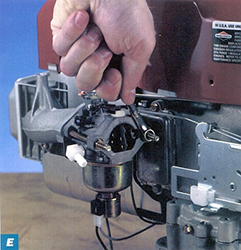
- Install the air cleaner assembly, making certain that the tabs on the bottom of the air cleaner are engaged.
More Carburetor Repair Resources




